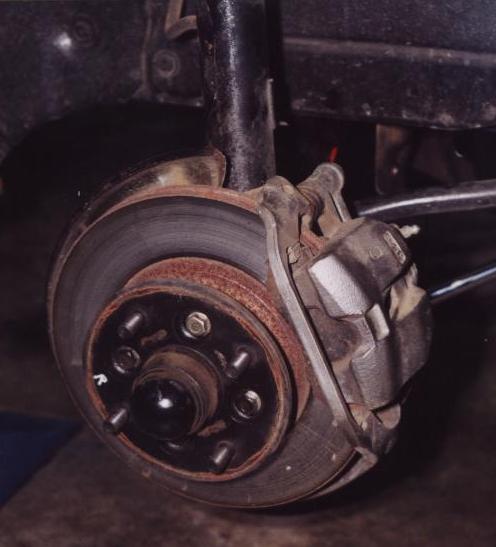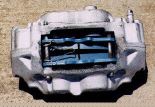
I have lengthened my control arms about 16mm each, using 4 arms to start with I made only one cut and weld. The red/gold polyurathane bushes are on there as well.
Understanding the problem
The problem with these cars is, they tend to have bump steer, the steering is very light and can wander, they understeer badly when driven into a corner, they roll badly when pushed hard around a corner, and generaly handle like a little boat. With 165 or even 175 tyres, this is no package to handle a engine transplant. Don't even think about increasing your power till you do something about suspension.
The understeer is designed into them on purpose to create a more predicatable feel. The way they have done this, it also translates into bump steer. Understeer can easily be the death of you and your car if you increase your power or drive in the wet.
How to fix the problems?
The standard KE30 has almost zero caster (to make the steering light) and either zero or positive camber (to suit old bias-ply tyres). To increase the grip of the front tyres (reduce understeer), we need some negative camber, and some dynamic camber. Dynamic camber is better because it places both wheels at the angle they should be for better grip, where as static negative camber only places the outside wheel ready for more grip. To get some negative camber I have increased the lower control arm length about 16mm so I now have -1.7 degrees camber or thereabouts. The length you change the control arms depends on what struts you are using. This also gives more track width. You can also change these angles using adjustable strut tops. To obtain dynamic camber, you increase the caster. This is easy, just wind up the nuts at the front of the radius rods to pull the bottom of the strut forward. You can do this as much as you dare, lots of caster is good. With more caster you will feel the steering is much heavier, but you will have alot more grip around corners.
To reduce roll, you can used bigger anti-roll bars, or stiffer springs or both.

I have lengthened my control arms about 16mm each, using 4 arms to start with I made only one cut and weld. The red/gold polyurathane bushes are on there as well.
| KE30 has | You Want | ||||||||||||||||||||||||||||||||||||||||
|---|---|---|---|---|---|---|---|---|---|---|---|---|---|---|---|---|---|---|---|---|---|---|---|---|---|---|---|---|---|---|---|---|---|---|---|---|---|---|---|---|---|
| Caster: | 1 deg? | 2.5-3 degrees | |||||||||||||||||||||||||||||||||||||||
| Camber: | +0.5 ? | -1.5 degrees | |||||||||||||||||||||||||||||||||||||||
| tyres: | 75 series | 60-50 series | |||||||||||||||||||||||||||||||||||||||
| tyre width: | 165mm | 185-195mm | |||||||||||||||||||||||||||||||||||||||
| front shocks: | oil | gas/oil catridge | |||||||||||||||||||||||||||||||||||||||
| rear shocks: | oil | gas/oil | |||||||||||||||||||||||||||||||||||||||
| front springs: | coil | coil, slightly stiffer | |||||||||||||||||||||||||||||||||||||||
| rear springs: | leaf | leaf, slightly stiffer | |||||||||||||||||||||||||||||||||||||||
| front anti-roll bar: | 19mm | 22-25mm | |||||||||||||||||||||||||||||||||||||||
| rear anti-roll bar: | none | 14-19mm | |||||||||||||||||||||||||||||||||||||||
| bushes: | rubber (old) | polyurathane | |||||||||||||||||||||||||||||||||||||||
| bump steer: | some | none | |||||||||||||||||||||||||||||||||||||||
Front Struts
I have used XT130 Corona struts at the front. The Corona struts (similar to Celeca/Supra/Cressida) come with much larger solid 266mm disks and slightly heavyer shocks and springs. They have single spot Girlock calipers. To fit the corona stuts on, you also need the matching steering knuckles. (RA23 knuckles fit the same as XT130 knuckles). This knuckle will fit on the corolla ball joint. I have cut the spring carrier off the corona struts and welded the KE30 corolla carrier on. (Angle grinder and TIG welder, with shock apart and drained). This is because the corona springs are too big and the tops are different. I now use KE70? corolla springs with only a 1/4 coil cut. Not all corolla springs are the same, so it can be interesting to find the different rates. While I had the struts apart, I used 20 weight shock oil designed for motorbike shocks. This is a heavyer weight which stiffens the shock and works well to easily increase the rate. It would be advised to get new gas shocks if you have the money. Once you go to these struts, other brakes can easily fit the same spindle. I got the Girlock brakes on the XT130 struts to fade a big because they are not vented.

Not that flash looking, but they are vented and bigger than the standard KE55 brakes.
Brakes
My current front brakes are becoming a common setup for RWD Corollas and Celicas. It was developed buy a few different Australians in 2003 comunicating on the internet!
4x4 HiLux 4-spot brake calipers with Puegeot vented disks
You need a pair of XT130 or RT132 Corona struts, with hubs. You also need the 4-spot brake calipers of a 4x4 HiLux, any model from LN106 to current. Then you need a pair of new front disks to suit a Puegeot 604, which are 20mm thick and have a 76mm hole in the center.
Toss the XT130 brakes and disks away, but keep the hubs and bearings. You can also toss the metal backing plates away if you want, or they will need to be cut to fit the HiLux brakes. The new vented disks need to have the 4 holes in the center drilled out slightly to the next size, which allows them to be bolted to the XT130 hubs. The disks also have to be machined down to 266mm in diameter, which is not hard to do if you have a lathe. Also, the disks need 1mm machined off the mounting face. The disk then will bolt to the hub perfectly, and the hub and be fitted to the stub axle with new gears etc and hub seal. The Hi-Lux caliper just bolts to the XT130 strut with no modification, it all fits. As is the pedal may be too solf and long, so use a 15/16" master cyclinder like what the HiLux has. A late model master cyclinder from a HiLux RZN167? is a 2 bolt and will just bolt on to the corolla booster. The MC from a LN106 is a 4 bolt so will not fit.
I was using 255 x 21mm vented disks from a early Tarago, and the matching Tarago calipers. The disks and hubs bolt right to the corona/celica spindal, but a adapter plate had to be made to fit the callipers. The brakes pistons are 2.25" in diameter. The master cylinder used on the same Tarago was 15/16". I now use a 2 bolt 13/16" master cylinder from a TE72 which bolts right to my 6" KE30 booster. The KE30 master cylinder is 3/4" and would have given a spongy feel with the bigger brakes, and pedal travel would have been a issue. Rather than use the Corona struts and adapt the Tarago brakes to fit, it would be better to just use Celica/Supra RA60/MA61 struts, as they have the vented 258mm brakes and same calipers already. The corolla spring conversion would still need to be done.

This shows the standard booster and resovirs I used off a early KE30, as I replaced the Australian items. And TE72 MC, and clutch MC. Note the brake valve and warning switch on the fire wall, also from the KE30.
The rear brakes are still drum, but are the larger ones with the Celica diff. These brakes are bigger than on the Japanese 6" diffs, but exactly the same as on the BorgWarner diffs in the KE55.
As a result I have good pedal feel and great fade free brakes designed for a larger car. Fade free on the road at least, but I'm sure time on the race track could get them to fade still.
To get huge 4 spot calipers that are cheaper than RX7 calipers, you can use the Toyota 4x4 4 spot calipers (Sumitomo). These will offer huge braking power. They come on all 4x4 HiLux and Landcrusiers with vented disks. Older Toyota 4x4's (79-84) also use 4 spot calipers but on solid disks, the only difference being the width between the pads.

These are the older 4x4 brakes, used on solid disks. The newer ones for vented disks are the same but are wider.
Anti-Roll bars
I have replaced the front anti-roll bar with a 22mm one found on some corollas of the same shape, (later KE38 or KE55 at wreckers). Doing this alone can increase understeer, so I also have a 16mm anti-roll bar on the back which balances it out ok, and keeps it fairly flat. My rear bar and front 22mm bar are factory items found on the latest KE55's of 1980-81. I am not sure if I'm totaly happy with handling these bars and springs give, but its all very cheap and a vast improvement over the stock setup.
Rear suspension
The rear is leaf springs, like all corollas up till the KE70 series starting about early 1981 (or 1979 in Japan). To stiffen them I have used Wagon main leafs (a bit thicker) with normal coupe leafs and a extra leaf from a wagon. The wagon leafs are different lengths so the pack is still of different lengths. I have a selection of different leaves which can be used to change the stiffness of the back. To lower it (and to counter the extra hiegh the extra leaf gives), I have tuned one leaf upside down. If you have a wagon, the thick bottom leaves (helper springs) should not be used, as the thick ones effect things negatively when you lower it. The bump stops can be cut in half to regain some travel. You should not lowered it too much because the rear shocks are mounted at an angle so lowering greatly reduces the effect of the shocks. It would be good to relocate the top shock mount so they are verticle. Turning a leaf spring upside down is not the best, but a cheap way to lower a bit. Idealy, the springs should have lube or some plasic spacing between them so they can slide against each other, and just work as a spring like they should and not bind up, letting the shock do all the damping.
Other lowering techniques
The easiest is to get lowering blocks with longer U bolts, you can buy this as a kit. You can also get the leafs reset at a different height. You can get the eyes reversed in the main leaf. You can get aftermarket single leafs made to suit your car.